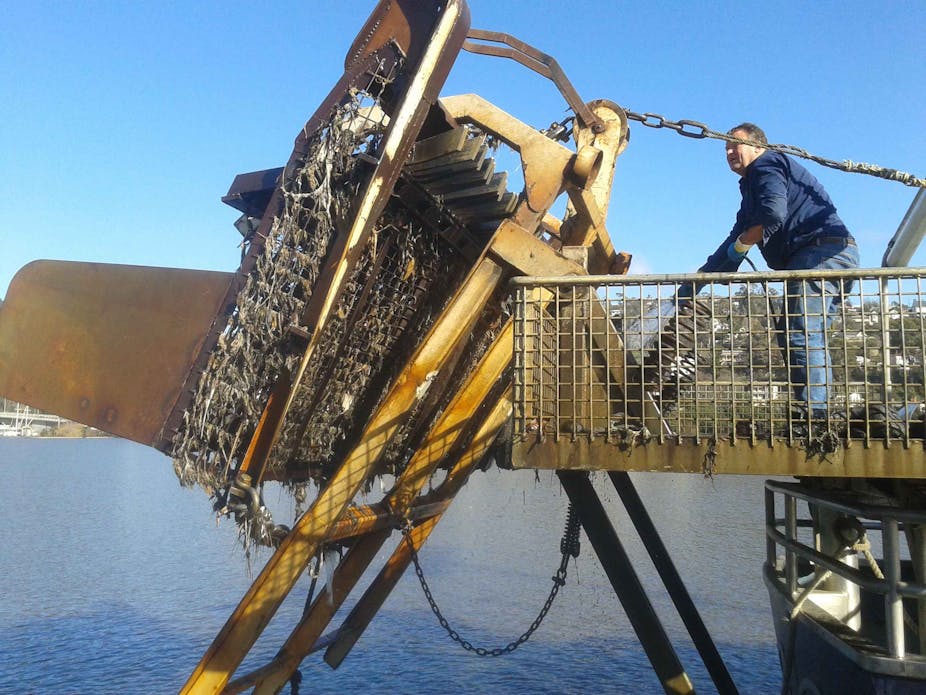Anyone flushing a toilet in urban Australia today does so confident that they’ll never again see the thing they’ve flushed. They probably also think they are causing minimal environmental harm, thanks to our well-designed wastewater treatment plants. But is our lack of concern for sewage pollution well founded? Recents events in northern Tasmania suggest not.
Launceston sits on the Tamar River estuary, in northern Tasmania. Residents have long been concerned about poor water quality and excessive sedimentation in the estuary. A recent study suggests the problem could be solved - or at least ameliorated - by releasing environmental flows from a hydroelectric dam and restoring wetlands to help the tide flush away sediment.
But meanwhile, the local government has decided to rake the Tamar’s silt as a stop-gap measure. This involves dragging a large rake from the stern of a fishing boat, stirring up the fine sediments that are then washed downstream on an ebb tide.
But the raking has brought unexpected consequences: it has exposed the size of Launceston’s sewage problem. Photos taken after a recent raking session on July 7, 2013, reveal a rake clogged with tampon strings. It’s been happening so often the rake operator has had to come up with a novel means of disentangling the strings from his equipment. He takes the rake home and burns the strings off in a fire in his backyard.

Why is there layer of tampon strings on the bed of the Tamar River estuary? The answer lies in ageing urban infrastructure. Launceston was established in 1806 - it is Australia’s third oldest city - and it now supports a regional population of 90,000. The sewage and stormwater runoff from older parts of the city are combined.
During high rainfall the secondary treatment plants cannot cope with the sudden increase in stormwater. So all wastewater (stormwater and raw sewage) is released directly into the estuary.
The old mantra “the solution to pollution is dilution” cannot be applied here: heavy rain does not make things better. Without intervention, wastes will continue to slosh backwards and forwards on the estuary’s tides, continuing to create the problems now so evident on Launceston’s doorstep.
The problem is made worse by the lack of tertiary treatment. Launceston has long needed a tertiary treatment plant but the cost, which will be borne by Tasmanian ratepayers, is large.
The tampon strings are not the major issue here – rather they are indisputable, physical evidence of the extent of sewage pollution. Normally such large amounts of decomposing organic material in the upper estuary would trigger toxic cyanobacterial blooms during warmer summer months.
But the low level of light in the estuary, caused by the naturally turbid waters, may be preventing this - the algae needs light to grow. However, cyanobacterial blooms are now becoming common in the clear waters of Trevallyn Lake further upstream on the South Esk River.
The problem of sewage overflows into natural waterways and wetlands is not restricted to Launceston. Sewage pumping stations throughout Australia are often close to streams or wetlands. The waterways are meant to be emergency receiving points when pumps fail or systems become overloaded.
As a freshwater ecologist I have worked on wetlands in both Perth (North Lake) and Melbourne (Huntingdale Lake) degraded by sewage spills. This form of organic pollution results in massive de-oxygenation, fish kills, bird deaths and swarms of nuisance insects (mosquitoes and midges).
The issue of how we deal with our waste products is one of the most pressing problems facing our planet. Under the global climate scenarios of increasing temperatures and more extreme events such as floods and droughts, the pollution caused by floods may cause more harm than previously recognised. The Launceston issue is a timely warning.
We have to ensure that urban wastewater infrastructure is designed to cope with extreme conditions. We need to understand how bad water quality can get if you combine organic pollution and a warming climate. If we don’t, the important biodiversity, recreational and aesthetic values of urban wetlands will disappear and the risk of water-borne and mosquito-borne diseases will increase.
These are scenarios we must not ignore.

